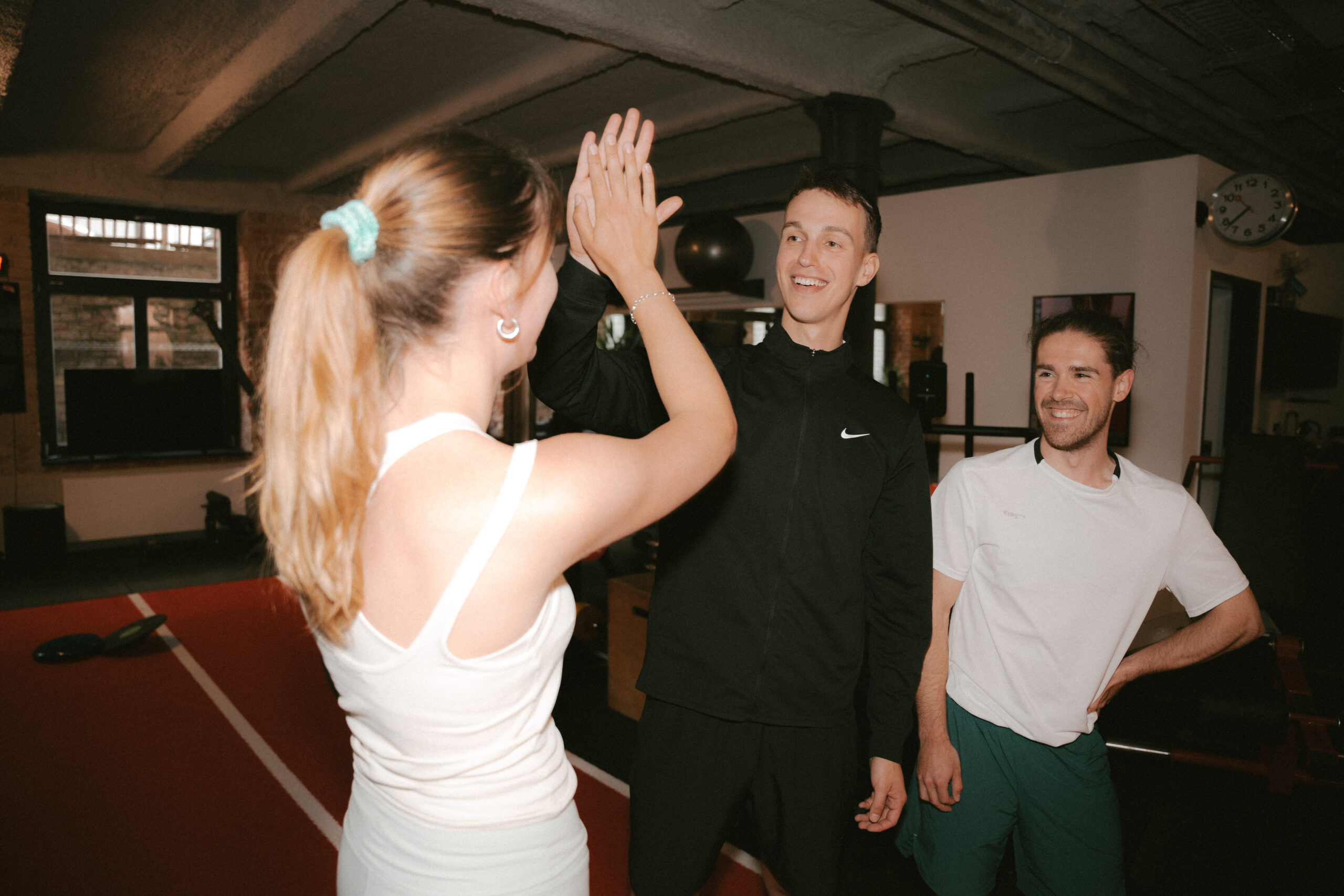- Ernährungsberatung
Fit-Connect
Ernährungsberatung
Für Privatpersonen mit langfristigen Ambitionen
Ernährungsberatung
Gesundheitsberatung führt zu Angeboten rund um das betriebliche Gesundheitsmanagement (BGM) - für Unternehmen und Bildungseinrichtungen.
- Personal Training
Fit-Connect
Personal Training
Für Einzelpersonen und Gruppen
Personal Training
Personal Training umfasst individuelle Trainings- und Coachingangebote – von Einzelcoaching über funktionelles Training bis hin zu Lifestyle-Coaching und digitalen Trainingsplänen – für eine gezielte, ganzheitliche Gesundheitsförderung.
- Funktionelles Training
Fit-Connect
Sportkurse
Für Gruppen
Sportkurse
Gesundheitsberatung führt zu Angeboten rund um das betriebliche Gesundheitsmanagement (BGM) - für Unternehmen und Bildungseinrichtungen.
Nächste Veranstaltung
Funktionelles Gruppentraining – gemeinsam stärker im Alltag (Dienstag)
16. September 2025
Boost Stability Fast: 5-Minute Balance Training Drills for All Levels
Balance training isn’t just for athletes or yoga enthusiasts—it’s a foundational skill that supports everyday movements, from climbing stairs to preventing falls. Studies show that poor balance contributes to over 300,000 hip fractures annually in the U.S. alone (National Institutes of Health), highlighting its critical role in long-term health. The good news? Even 5 minutes of targeted drills can significantly enhance stability, regardless of your fitness level. Let’s dive into actionable exercises, backed by science, to help you build a stronger, steadier body.
Why Balance Training Matters: More Than Just Standing on One Leg
Balance training improves proprioception—your body’s ability to sense its position in space—by strengthening muscles, joints, and neural pathways. Benefits include:
- Injury prevention: Stabilizing muscles protect joints during dynamic movements.
- Enhanced athletic performance: Better control = more power and agility.
- Fall reduction: Older adults who practice balance exercises lower their fall risk by up to 24% (Journal of the American Geriatrics Society).
- Posture correction: Combats slouching and back pain from sedentary habits.
Balance exercises fall into two categories:
- Static (e.g., standing on one leg).
- Dynamic (e.g., walking heel-to-toe).
Combining both types delivers the best results.
5-Minute Balance Training Drills for Every Fitness Level
Beginners: Lay the Foundation
1. Static Single-Leg Stand
- How: Stand tall, shift weight to one leg, and lift the other knee to hip height. Hold for 20–30 seconds.
- Focus: Engage your core and fix your gaze on a stationary object.
- Modification: Touch a wall for support if needed.
2. Heel-to-Toe Walk
- How: Walk in a straight line, placing your heel directly in front of the opposite foot’s toes. Do 10 steps.
- Pro Tip: Pretend you’re on a tightrope to activate stabilizing muscles.
Why it works: Builds coordination and ankle stability.
Intermediate: Add Controlled Movement
1. Clock Reach
- How: Stand on one leg. Imagine a clock face around you, and tap your free foot to “12,” “3,” “6,” and “9.” Repeat 5x per side.
- Challenge: Add light ankle weights or close your eyes.
2. Split Squat with Pause
- How: Step one foot back into a lunge. Hold for 5 seconds, then return. Alternate sides for 8 reps.
- Focus: Keep your front knee aligned over your ankle.
Why it works: Strengthens quads and glutes while improving unilateral control.
Advanced: Test Your Limits
1. Single-Leg Deadlift
- How: Hold a water bottle or dumbbell in one hand. Hinge at the hips, lifting one leg backward. Return to start. Do 8–10 reps per side.
- Pro Tip: Keep your torso parallel to the floor for maximum hamstring activation.
2. Bosu Ball Balance with Arm Swings
- How: Stand on a Bosu ball (flat side up). Swing arms overhead while maintaining stability. Time yourself for 60 seconds.
- Upgrade: Try mini squats or tossing a ball against a wall.
Why it works: Unstable surfaces intensify proprioceptive demands.
Maximize Results: 3 Science-Backed Tips
- Practice Daily: Consistency trumps duration. Even 2–3 minutes daily improves balance faster than weekly sessions.
- Pair with Strength Training: Combine drills with exercises like planks or step-ups for full-body stability.
- Track Progress: Use your phone to time single-leg stands weekly. Aim to add 5 seconds each session.
Sneak Balance Training Into Your Routine
- Brushing your teeth: Stand on one leg for the duration.
- Waiting for coffee: Do calf raises or heel-to-toe stands.
- Post-workout cooldown: Add 2 minutes of dynamic balance moves.
Fazit: Stability Starts with Small, Smart Habits
Balance training is a low-time, high-reward habit that keeps your body resilient at any age. By dedicating just 5 minutes a day to these drills, you’ll enhance mobility, reduce injury risks, and move with confidence. Start with one exercise today and gradually layer in complexity as your skills improve.
Your Next Step: Ready to personalize your balance routine? Vereinbaren Sie jetzt ein kostenloses Beratungsgespräch mit unserem Expertenteam bei Fit-Connect und erhalten Sie einen maßgeschneiderten Trainingsplan.
FAQ: Balance Training – Kurz und Klar
1. Wie oft sollte ich Balanceübungen machen?
Optimieren Sie Ihre Stabilität mit 5–10 Minuten täglichem Training. Studien zeigen, dass kurze, häufige Sessions effektiver sind als gelegentliche lange Workouts.
2. Können auch ältere Menschen diese Übungen sicher durchführen?
Ja! Beginnen Sie mit stützenden Varianten (z. B. am Tresen festhalten) und steigern Sie die Intensität schrittweise. Balanceworkouts sind besonders effektiv zur Sturzprävention ab 60+.
3. Brauche ich Equipment für Balanceübungen?
Nein. Alles, was Sie benötigen, ist Ihr Körpergewicht. Fortgeschrittene können instabile Untergründe (Kissen, Balanceboards) oder Gewichte hinzufügen.
Neueste Beiträge
Keine Neuigkeiten von Fit Connect verpassen? Folge uns!
Kategorien
Aktuelle Forschung & Trends der Sportwissenschaft
Biomechanik
Ernährungsstrategien für unterschiedliche Trainingsziele
Ernährung und Sport
Interdisziplinäre Ansätze
Körperliche Leistung & Biomechanische Optimierung
Personalisierte Trainingsansätze
Praxisorientierte Forschung
Regeneration und Erholung
Sportpsychologie im Personal Training
Schlagwörter
bewegungspräzision
bewegungssteuerung
bewegungsökonomie verbessern
biomechanik im krafttraining
biomechanische analyse
coaching für mentale fitness
Elektrolyte auffüllen
energieeffizienz beim sport
explosivität im sport
fußmechanik
ganganalyse
gelenkbelastung reduzieren
Gesundheitsförderung
Hydration und Regeneration
hüftmobilität steigern
individuelles Functional Training
kaloriendefizit berechnen
kinematik
kraft-last-verhältnis
kraftfluss im körper
kraftübertragung optimieren
körperhaltung verbessern
laufökonomie
leistungsdiagnostik
low carb beim training
Mental Coaching
mentale ermüdung sport
muskel-sehnen-interaktion verbessern
muskelaufbau diät
muskelermüdung reduzieren
muskelkoordination
Nahrungsergänzung für Regeneration
neurodynamik
posturale kontrolle
pre-workout ernährung
Präventionstraining
regenerationstechniken
sehnenelastizität
sportliche Leistungssteigerung
sportverletzungen vorbeugen
sprinttechnik
sprungmechanik verbessern
tiefenmuskulatur aktivieren
turnen biomechanisch analysieren
widerstandstraining

